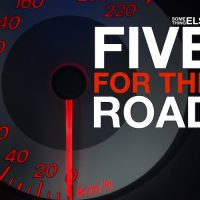Steve Gadd takes us inside mythical sessions with Paul Simon, Paul McCartney and Steely Dan. He also goes in depth on his lengthy working relationships with Eric Clapton and Chick Corea, with whom he has recorded and toured for decades.
Gadd’s latest project has a similar star power: The Gaddabouts, who issued a brilliant double-discer called Look Out Now! on Tuesday, also includes former New Bohemians singer Edie Brickell, Who bassist Pino Palladino and Roger Waters guitar player Andy Fairweather Low.
[SOMETHING ELSE! INTERVIEW: Do-anything drummer Steve Gadd talks about his newest project, the roots-rocking all-star Gaddabouts, as well as his life-long interest in jazz.]
These older sessions, both through the lessons learned and the connections made in order to construct his new supergroup, inform Look Out Now! in ways large and small — though the understated, easy-going Gadd isn’t one to brag. A musician’s musician, he approaches every session with a down-to-earth craftsman’s attitude.
Never the less, more often than not, something magic happens. Gadd may be the most low-key legend there ever was.
“50 WAYS TO LEAVE YOUR LOVER,” with PAUL SIMON (STILL CRAZY AFTER ALL THESE YEARS, 1975): Paul Simon’s only Billboard Hot 100 No. 1 smash, “50 Ways” takes a humorous tack on a relationship’s disintegration, with winkingly memorable lines like: “Just slip out the back, Jack; make a new plan, Stan” But not before Gadd sets the tone with a polyrhythmic, somewhat militaristic opening signature. The drummer had, actually, been a member of the Army Music Program — but the impetus for this musical moment comes from a far more straight-forward place.
STEVE GADD: I was practicing between takes. That’s how that started. When I was a kid, I played in drum and bugle corps, and I used to write drum parts. That’s sort of where the inspiration came, subconsciously. So, I was creating different combinations between the hi-hat, snare and bass drum. I was playing the hi-hat with my left hand. Paul and Phil Ramone (producer for the session) heard me, and suggested that I do something like that with the intro. It was really a group effort, a situation where everybody contributed. When you do a session like that, you do whatever makes it work for the artist, and you hope it will be a hit — but you never know. I just try to give the best I can.
“TAKE IT AWAY,” with PAUL McCARTNEY (TUG OF WAR, 1982): When Gadd arrived for these McCartney sessions in early 1981 at Beatles producer George Martin’s Air Studios, the drummer was joining a group that also included Ringo Starr — but their reunion was colored by John Lennon’s recent murder. They’d complete the upbeat single “Take It Away,” which would spend five weeks on the Billboard singles chart while ultimately reaching No. 10, but Gadd says the loss of the Beatles bandmate was keenly felt.
STEVE GADD: It was a big impact. It wasn’t morbid there, but there was a lot of security around. Not where we could see them, but we knew that they had the perimeter set up and that they were being very careful. It was just a hard time. We didn’t really talk about John a lot. Everyone was just trying to get on with it, you know? I’m glad I was there. Playing with those guys was quite an experience.
“FRIENDS,” with CHICK COREA (FRIENDS, 1978): This Grammy-winning album arrived amid a flurry of activity for Corea, who issued three studio albums and two live projects in 1978. Friends marked a move away from the string- and horn-laden sessions of his most recent albums, pairing Corea with Gadd, Eddie Gomez and Joe Farrell. Gadd, of course, had a lengthy history already with Corea — who has called him “the finest musician I’ve ever played with.” The drummer was part of the second edition of Corea’s Return to Forever, though Gadd never recorded with the group. He also appeared on the Corea solo albums The Leprechaun and Three Quartets.
STEVE GADD: With Chick, none of the drum parts were written. I would read Chick’s scores, to see what he was playing, and then I would choose what accents to play. That’s why Chick’s music was always so great to play. It’s challenging music, very inspiring.
[SOMETHING ELSE! INTERVIEW: Eric Clapton biographer Chris Welch, a longtime friend, surveys the guitarist’s life and career in the 2012 book ‘Clapton: The Ultimate Illustrated History.’]
“PILGRIM,” with ERIC CLAPTON (PILGRIM, 1998): Eric Clapton’s first album of original material since 1989’s Journeyman found the guitarist delving into R&B grooves, deeply emotional themes and the previously unexplored upper register of his voice — all just ahead of Gadd’s driving rhythms. The drummer has toured with Clapton off and on since 1994, including a lengthy stretch from 1997-2004. In all, he’s been part of four Clapton studio projects as well as the guitarist’s 2000 collaboration with B.B. King, Riding with the King — and also appeared with Clapton during a legendary 11-night stand at the Royal Albert Hall in 2009.
STEVE GADD: I try to be supportive of where he seems to be going when he’s soloing, in dynamic terms. Some nights, he’s really going for it, and you’ve got to be able to stay with him and be supportive the whole way. Other nights, it might not go as long — depending on how tired he is, how much traveling we’ve been doing, and just how he feels. What kind of feedback from the audience, it all plays a part in the way we are going to play that night. He’s an amazing guy. It’s not an accident that he’s as successful as he is. He plays 100 percent, 110 percent. His singing is unbelievable. He’s constantly listening to different things, and trying different things, and bringing different people in and out of the band. He’s constantly growing. He’s a pretty amazing person. He brings different drummers in at different times. I have been doing it now, on and off, for over 10 years — and I enjoy it — but he’s brought different people in, and that’s good for him. He gets to feel it a little bit differently. I think that’s what keeps him going.
“AJA,” with STEELY DAN (AJA, 1977): The eight-minute title song to Steely Dan’s sixth, and best-selling album, brilliantly combines jazz and rock with its fiery interplay between Gadd and saxophonist Wayne Shorter, best known for his work with Miles Davis and Weather Report. Only Gadd recorded his titanic drum fills live — and, he says, in one surprising take no less — with the rest of the legendarily picky members Steely Dan. Shorter was brought in later and recorded his answering solo signature over their already completed parts. The results were as big a surprise to Gadd as they were to everyone else.
STEVE GADD: The band and the drums, we did that part of the track live, and then Wayne put his thing on at the end. I was in L.A. working on something else, and they called me. They asked for fills between the figures they already had. Back then, there were all of these stories about Becker and Fagen never being satisfied for one reason or another, but we just sort of sailed through everything. We did the song live in the studio and then Wayne overdubbed his parts after. So, I wasn’t even there when he did it — unfortunately. I would have loved to have been there! I love Wayne. I didn’t even know at the time that’s what was happening, but that’s what it turned out to be.
- How Deep Cuts on ‘Music From Big Pink’ Underscore the Band’s Triumph - July 31, 2023
- How ‘Islands’ Signaled the Sad End of the Band’s Five-Man Edition - March 15, 2022
- The Band’s ‘Christmas Must Be Tonight’ Remains an Unjustly Overlooked Holiday Classic - December 25, 2016




